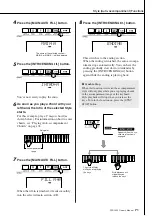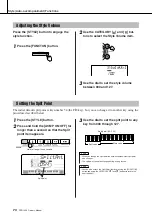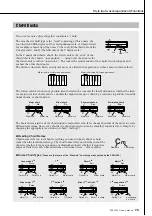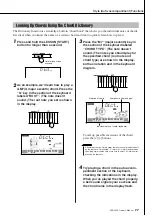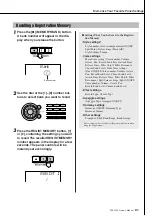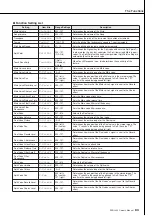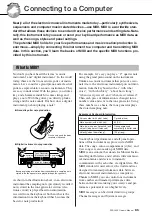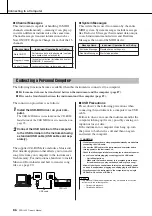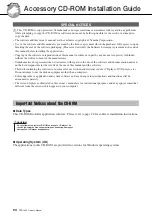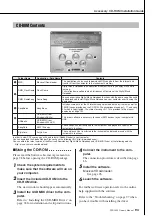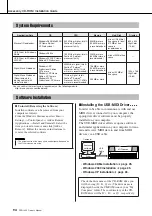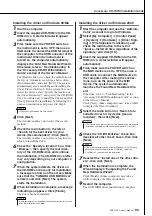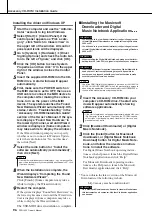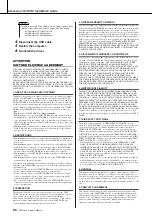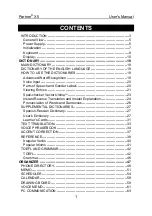
R
ef
erenc
e
PSR-I425 Owner’s Manual
85
Connecting to a Computer
Nearly all of the electronic musical instruments made today—particularly synthesizers,
sequencers and computer music related devices—use MIDI. MIDI is a worldwide stan-
dard that allows these devices to send and receive performance and setting data. Natu-
rally, this instrument lets you save or send your keyboard performance as MIDI data, as
well as the songs, styles and panel settings.
The potential MIDI holds for your live performances and music creation/production is
enormous—simply by connecting this instrument to a computer and transmitting MIDI
data. In this section, you’ll learn the basics of MIDI and the specific MIDI functions pro-
vided by this instrument.
No doubt you have heard the terms “acoustic
instrument” and “digital instrument”. In the world
today, these are the two main categories of instru-
ments. Let’s consider a grand piano and a classical
guitar as representative acoustic instruments. They
are easy to understand. With the piano, you strike a
key, and a hammer inside hits some strings and
plays a note. With the guitar, you directly pluck a
string and the note sounds. But how does a digital
instrument go about playing a note?
As shown in the illustration above, in an electronic
instrument the sampling note (previously recorded
note) stored in the tone generator section (elec-
tronic circuit) is played based on information
received from the keyboard. So then what is the
information from the keyboard that becomes the
basis for note production?
For example, let’s say you play a “C” quarter note
using the grand piano sound on the instrument.
Unlike an acoustic instrument that puts out a reso-
nated note, the electronic instrument puts out infor-
mation from the keyboard such as “with what
voice”, “with which key”, “about how strong”,
“when was it pressed”, and “when was it released”.
Then each piece of information is changed into a
number value and sent to the tone generator. Using
these numbers as a basis, the tone generator plays
the stored sampling note.
Example of Keyboard Information
Your keyboard performance and all panel opera-
tions of this instrument are processed as MIDI
data. The songs, auto accompaniment (styles), and
User songs are also made up of MIDI data.
MIDI is an acronym that stands for Musical Instru-
ment Digital Interface and it allows different musi-
cal instruments and devices to instantly
communicate with each other, via digital data. The
MIDI standard is used all over the world and was
designed to transmit performance data between
electronic musical instruments (or computers).
Thanks to MIDI, you can control one instrument
from another and transmit performance data
between the devices-taking your creative and per-
formance potential to even higher levels.
MIDI messages can be divided into two groups:
Channel messages and System messages.
What Is MIDI?
●
Acoustic guitar note production
Pluck a string and the body
resonates the sound.
●
Digital instrument note production
Based on playing information from the keyboard, a sampling note
stored in the tone generator is played through the speakers.
Playing the keyboard
Tone Generator
(Electronic circuit)
L
R
Sampling
Note
Sampling
Note
Voice number (with what voice)
1 (grand piano)
Note number (with which key)
60 (C3)
Note on (when was it pressed) and
note off (when was it released)
Timing expressed
numerically (quarter note)
Velocity (about how strong)
120 (strong)
Содержание PortaTone PSR-I425
Страница 1: ...Owner s Manual EN ...
Страница 2: ...2 PSR I425 Owner s Manual ...
Страница 101: ...Scores PSR I425 Owner s Manual 101 ...
Страница 103: ...Scores PSR I425 Owner s Manual 103 ...
Страница 105: ...Scores PSR I425 Owner s Manual 105 ...
Страница 126: ...126 PSR I425 Owner s Manual ...

